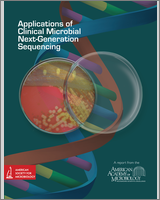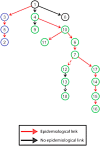Case Study 10WGS tracks a hospital outbreak of carbapenem-resistant K. pneumoniae (97)
Carbapenems are the most potent class of b-lactams, and with the emergence of carbapenem-resistant strains, treatment options have become extremely limited. The U.S. NIH Clinical Center had a carbapenem-resistant K. pneumoniae outbreak that afflicted 18 people and resulted in 11 deaths (Figure). WGS and epidemiological analysis demonstrated that the outbreak source stemmed from a single patient who had been discharged 3 weeks prior to the appearance of clinically relevant cases. The index patient independently transmitted the outbreak strain at least three times to create two main clusters of patients. K. pneumoniae is also an organism that can secretly colonize the gastrointestinal tract of patients without causing overt signs of infection. These patients act as silent transmission vectors, allowing an outbreak to develop covertly over a time period, as evidenced by this study. This case highlights how NGS can help to limit the nosocomial transmission of pathogens and thereby guide infection control efforts.
Putative map of K. pneumoniae transmission during a hospital outbreak.

